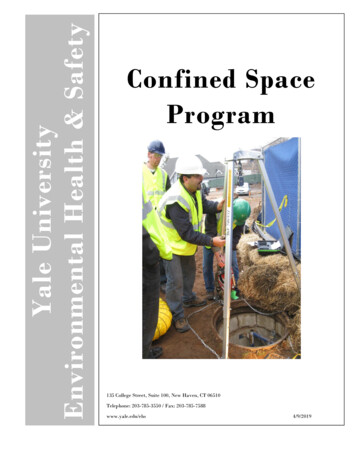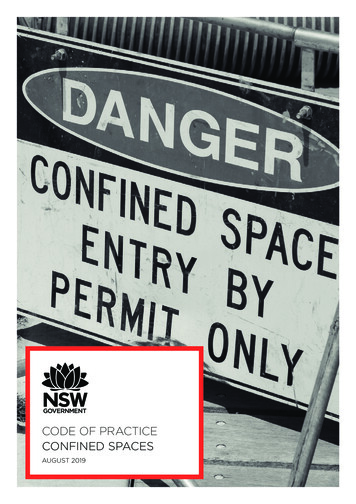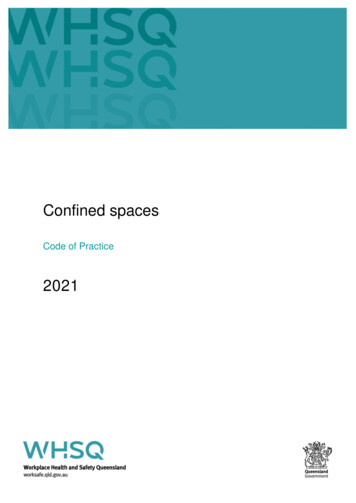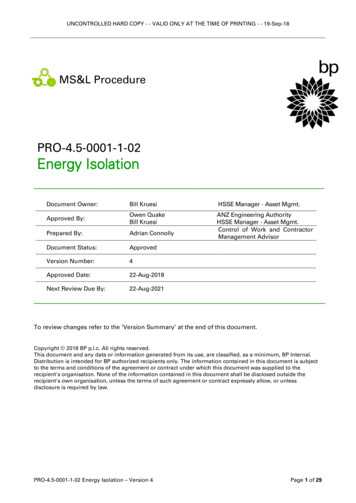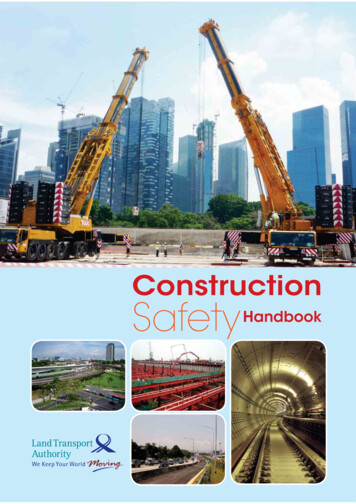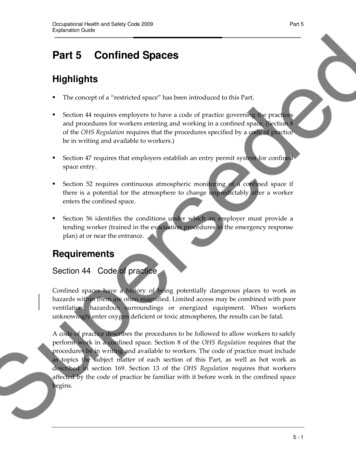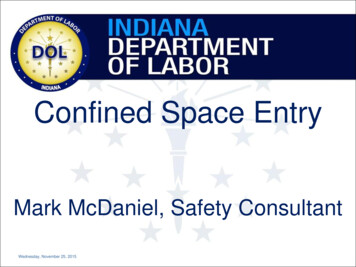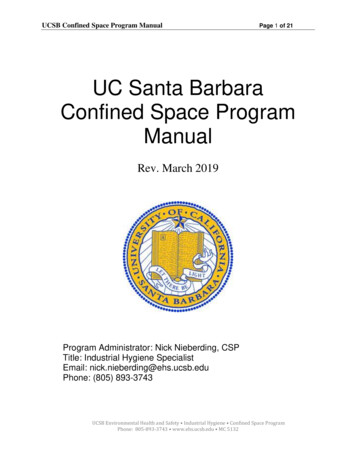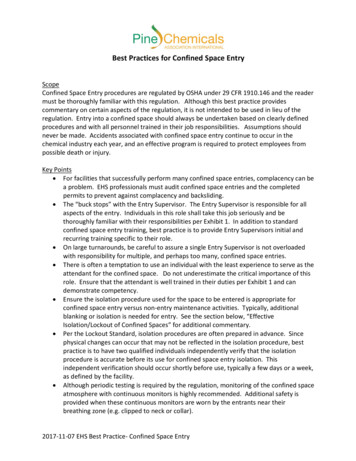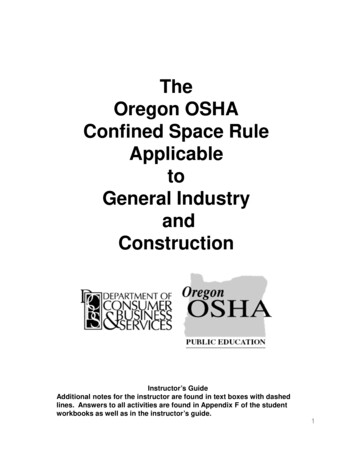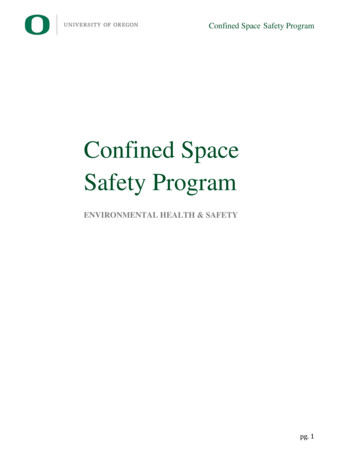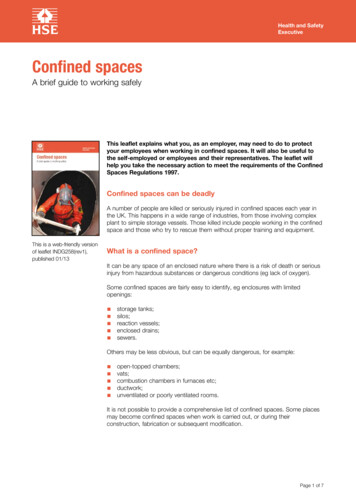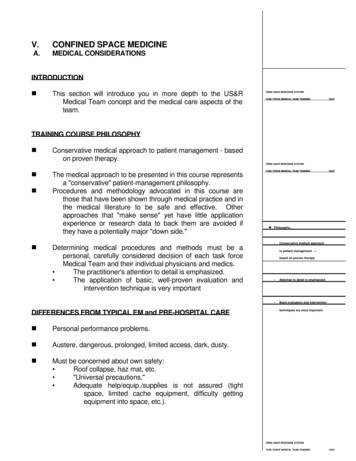
Transcription
V.CONFINED SPACE MEDICINEA.MEDICAL CONSIDERATIONSINTRODUCTIONnThis section will introduce you in more depth to the US&RMedical Team concept and the medical care aspects of theteam.FEMA US&R RESPONSE SYSTEMTASK FORCE MEDICAL TEAM TRAINING04/97TRAINING COURSE PHILOSOPHYnConservative medical approach to patient management - basedon proven therapy.FEMA US&R RESPONSE SYSTEMnnnThe medical approach to be presented in this course representsa "conservative" patient-management philosophy.Procedures and methodology advocated in this course arethose that have been shown through medical practice and inthe medical literature to be safe and effective. Otherapproaches that "make sense" yet have little applicationexperience or research data to back them are avoided ifthey have a potentially major "down side."TASK FORCE MEDICAL TEAM TRAININGn Philosophy. Determining medical procedures and methods must be apersonal, carefully considered decision of each task forceMedical Team and their individual physicians and medics. The practitioner's attention to detail is emphasized. The application of basic, well-proven evaluation andintervention technique is very importantDIFFERENCES FROM TYPICAL EM and PRE-HOSPITAL CAREnPersonal performance problems.nAustere, dangerous, prolonged, limited access, dark, dusty.nMust be concerned about own safety: Roof collapse, haz mat, etc. "Universal precautions." Adequate help/equip./supplies is not assured (tightspace, limited cache equipment, difficulty gettingequipment into space, etc.).04/97Conservative medical approachto patient management —based on proven therapy Attention to detail is emphasized Basic evaluation and interventiontechniques are most importantFEMA US&R RESPONSE SYSTEMTASK FORCE MEDICAL TEAM TRAINING04/97
FEMA US&R RESPONSE SYSTEMTASK FORCE MEDICAL TEAM TRAINING MANUALV.CONFINED SPACE MEDICINEA.MEDICAL CONSIDERATIONS04/97MEDICAL CARE PROBLEMSnInherent delay in reaching trapped patients.nSo there is progression of trauma/medical problems beyondthat normally seen in pre-hospital trauma management.nUnselected victim population. Nonselective process of victim involvement: Hospitalnursery (infants), nursing home (elderly, many withbaseline medical problems), psychiatric patients,HIV/TB patients, etc. The probability of the victims having baseline medicalproblems is significant.nUnusual medical problems. Crush syndrome. Haz mat injury. Airway dust impaction, etc.nUnable to "scoop and run." Patients may be trapped with prolonged extrication oregress from the structure, transport delayed, etc.TASK FORCE MEDICAL TEAM TRAINING04/97n Earthquake injury patterns —Wide variations due to multiple factors.nInadequate medical back-up. Medical system chaos secondary to loss ofcommunications, overwhelmed/ compromised EMSand hospitals, loss of medical personnel, workersoccupied with personal/family calamity X 3-5 dayspost-event. Characteristic of the quake Time of day and consequentlocation of population Building and groundcharacteristics"THE PROBLEM:" Overview of Injury Patterns/Medical Problems Type of responsen Ability to document typesnEarthquake injury patterns (i.e., injury patterns in collapsedstructure victims).Wide variation due to multiple factors: Characteristics of the quake. Magnitude, length of shaking, type of force waves, etc. Examples: Loma Prieta 15 sec. vs. Armenia's 45 sec. X2of injuries/deaths
FEMA US&R RESPONSE SYSTEMTASK FORCE MEDICAL TEAM TRAINING MANUAL two shakes.Time of day and consequent location of population.304/97
FEMA US&R RESPONSE SYSTEMTASK FORCE MEDICAL TEAM TRAINING MANUALV.CONFINED SPACE MEDICINEA.MEDICAL CONSIDERATIONS04/97"THE PROBLEM:" Overview of Injury Patterns/Medical Problems(continued)nIf a workday, people are more likely to be in large structures(schools, factories, hotel conference rooms) that aresusceptible to collapse. Examples: Armenia: daytime so in schools, factories. Loma Prieta: World Series cleared the Cypress. Tangshan: night-time quake w/ preceding tremble, manylumbar spine injuries from sitting up in bed and thenroof falling.nBuilding and ground characteristics. Building characteristics include its age, size, materials. These determine how much it will sway and when/how itwill fail. Example is Armenia with most buildingsfailing and with a high death-to-injury ratio. Type of soil important because "liquefaction" causes thehighest likelihood of structure collapse; this was esp.evident in Mexico City with soil differences. Impacts on amount of "shaking" the building enduresand how resistant the buildings are to collapse. Building occupancy: i.e. hospital, nursing home, TBsanitarium, pesticide factory, news building, etc.nType of response. A fast response will find patients with more acutemedical problems (this population would be founddeceased by a slower response team.nAbility to document types of injuries/deaths. For example, hypothermia is rarely noted as a problem,even in the Armenian earthquake, probably becauseno temps are taken.nEach disaster is different with unpredictable effects, so onlygeneralities are helpful (no two events are alike).4
FEMA US&R RESPONSE SYSTEMTASK FORCE MEDICAL TEAM TRAINING MANUAL04/97FEMA US&R RESPONSE SYSTEMV.CONFINED SPACE MEDICINEA.MEDICAL CONSIDERATIONSTASK FORCE MEDICAL TEAM TRAINING04/97FEMA US&R RESPONSE SYSTEMEARTHQUAKE INJURY PATTERNSnValid generalizations: "Golden Day": the first 24 to 48 hours after impact. After this period, there is a consistent and dramatic dropoff in the percent of victims found alive.n Death from trauma —classification by natural history. Immediate or "Golden Hour"-nInjury-severity classification: Patients consistently fall into categories classified bywhen they would die if untreated. Not an issue in disasters4-24 hours-Shock-Airway compromise, etc.-Intervention is crucialto survivalDEATH FROM TRAUMA nClassification by natural history: Immediate or "Golden Hour" trauma patients - not anissue in disasters. These patients will be dead when finally reached orunsalvageable due to lack of resources (proximity toan operating room, blood bank, ICU, etc.).nPatients who will die in 4 to 24 hours if untreated (shock, airwaycompromise, etc.) — intervention is crucial to survival.nPatients who will die later if untreated prior to reaching definitivecare facility (from sepsis, multi-organ failure, etc.) Intervention during rescue is possibly life-saving.Late-Sepsis-Multi-organ failure, etc.-Intervention possibly life-savingTASK FORCE MEDICAL TEAM TRAININGFACTORS IN VICTIMS' DEATHnEntrapment.nSeverity of injury.04/97n Earthquake injury patterns —valid generalizations.nInjury deteriorating prior to medical intervention.nWe cannot control these variables. Time to rescue and medical treatment This is where our program can make a difference. "Golden 24-48 hours" Injury-severity classification Commonlyseen injuriesFEMA US&RRESPONSE SYSTEM5TASK FORCE MEDICAL TEAM TRAINING Group of unusual injuriesn Earthquakes —factors in victim death1/93
FEMA US&R RESPONSE SYSTEMTASK FORCE MEDICAL TEAM TRAINING MANUALV.CONFINED SPACE MEDICINEA.MEDICAL CONSIDERATIONS04/97FACTORS IN VICTIMS' DEATH (continued)nThere is a group of common injuries that are frequently seen incollapsed-structure victims.Common medical careproblems incurred by collapsed-structure victims: Fractures/lacerations. Multiple trauma. Closed head injury. Hypothermia. Dehydration.nMany of these are common to everyday EMS and EmergencyDepartment care.nGroup of unusual injuries seen commonly in collapsed-structurevictims. Some are unusual entities, others are unusual variationsfrom typical pre-hospital setting.UNUSUAL MEDICAL CARE PROBLEMS AND VARIATIONS OFCOMMON PROBLEMSnCrush injury and syndrome. This has been noted to be a leading cause of victimdeaths in some earthquakes.nDust impaction/airway injury. Occurs from the dense cloud of dust generated by thecollapsing structure; exacerbated by resuspension ofdust during rescue efforts.nHaz mat injuries.nProlonged untreated trauma. Common trauma injuries that have had time to progressand problems that require adaptations because ofthe circumstances.nPain control in the pre-hospital setting.6
TASK FORCE MEDICAL TEAM TRAINING04/97FEMA US&R RESPONSE SYSTEMTASK FORCE MEDICAL TEAM TRAINING MANUALV.CONFINED SPACE MEDICINEA.MEDICAL CONSIDERATIONS04/97n Objective. "To bring EMS, emergencymedicine, and critical careto the patient."UNUSUAL MEDICAL CARE PROBLEMS AND VARIATIONS OFCOMMON PROBLEMS (continued)n Who is it? nStructure type and injury pattern. Certain kinds of collapsed structures allow generalpredictions of types of injuries. Wood structures: lacerations and punctures. Adobe and brick: dust impaction airway injuries.Members of an integrated team-cave rescue teams-FEMA US&R task force A group allied with a rescue team (SMRTeam) Local EMS/medical personnelallied with rescuers on-sceneOVERVIEW OF CONFINED SPACE MEDICAL CAREnTraditional phases of patient care: 1)Pre-hospital (EMS). 2)Emergency medicine (ED). 3)Surgery/critical care (OR/ICU). 4)Convalescence (hospital ward). 5)Rehabilitation (outpatient).nUnfortunately, we cannot expect to follow this course with ourpatients, due to the circumstances.n"SCOOP and RUN" ? With victims in a collapsed-structure disaster, this isoften not possible.nConfined space medical response objective. Therefore, we must bring EMS, emergency medicine andcritical care to the patient.nConfined space medical response. Who is it? Members of an integrated team (cave rescue teams,FEMA US&R Task Force Medical Teams). A group allied pre-incident with a rescue team(SMRTeam with mine rescue teams). Local EMS/medical personnel allied on-scene withrescuers (everyday incidents).nThe objective for this type of course is to benefit all of thesegroups.7
FEMA US&R RESPONSE SYSTEMFEMA US&R RESPONSE SYSTEMTASK FORCE MEDICAL TEAM TRAINING MANUALV.CONFINED SPACE MEDICINEA.MEDICAL CONSIDERATIONSTASK FORCE MEDICAL TEAM TRAINING04/9704/97n Rapidly deployableOVERVIEW OF CONFINED SPACE MEDICAL CARE (continued)n Self-supportingnn Relatively sophisticated capabilityConfined space medical requirements.These are therequirements to provide effective confined space medicalcare for all types of medical teams: Rapidly deployable. Self-supporting. Relatively sophisticated medical capability. Integrated into the disaster response structure.nAdequately prepared with: Medical equipment. Protective capability. Survival ability.nFEMA US&R Medical Team. Same level of sophistication as the search, rescue andother components of the task force.n Integrated into the disasterresponse structuren Prepared: Medical equipment Protective capability Survival abilityCONFINED-SPACE MEDICAL CARE OBJECTIVESnIncreased survival/decreased morbidity. By prompt patient stabilization (but we are not talkingabout setting up an ICU in the rubble!).nExpedite extrication by providing: Stabilization of vital signs (less pressured extrication). Immobilization of fractures, etc. Pain control. Improved victim cooperation from the above and bypatient reassurance. Specialized extrication technique. Anatomic/physiologic advice for moving patient. Prepare patient for hand-off to appropriate acceptingEMS personnel.nCollapsed structure extrication is not the same as vehicularextrication. Extrication difficulties: You can't just pop the top 8 floors of a 10-story buildingwith a Jaws of Life.8FEMA US&R RESPONSE SYSTEMTASK FORCE MEDICAL TEAM TRAININGn Increase survival/decrease morbidityn Expedite the extrication Stabilize the patient Immobilize fractures04/97
FEMA US&R RESPONSE SYSTEMTASK FORCE MEDICAL TEAM TRAINING MANUAL 04/97So must be knowledgeable in how to move the patient.9
FEMA US&R RESPONSE SYSTEMTASK FORCE MEDICAL TEAM TRAINING MANUALV.CONFINED SPACE MEDICINEA.MEDICAL CONSIDERATIONS04/97CONFINED SPACE MEDICINE OPERATIONAL APPROACHnOverview of the approach to medical care in confined spaces.nOperational approach: #1Rescuer safety first!confined space: physical, atmospheric,haz mat. #2"ABCs" - same basic approach as EMS/ED care.patient: "universal precautions." #3For difficult problems — use a sound approach("Think").this should be done by combining thestrengths of both doctors and medics.TASK FORCE MEDICAL TEAM TRAINING04/97n Acquire patient data ASAPn Monitor Rescue Team'simpact on victimn Evaluation begins withfirst voice contactOVERVIEW OF CSM MEDICAL PRACTICEn Prep equipment beforehandnAcquire patient data from earliest possible time. Victim-specific information: ask bystanders/family aboutpatient's age, PMH, etc. Ask about possible hazards in the structure (chemicals,etc).n Efficient evaluation/treatmentn Coordinate with Rescue Teamn Full evaluation outside structurenMonitor Rescue Team's activities for impact on patient: CO production, dust, etc. Remember to also monitor for impact on the rescuers(fatigue, dehydration, dust, etc.).nPatient evaluation begins as soon as there is voice contact withvictim.nPrepare and pre-position your equipment prior to accessingpatient.nEfficient evaluation/treatment performed to minimize rescuetime.nCoordinate ongoing evaluation/treatment with Rescue Teamactivities.n Hand-off issuesTASK FORCE MEDICAL TEAM TRAININGn Rescuer Safety First10 Confined space-Physical-Atmospheric04/97
FEMA US&R RESPONSE SYSTEMTASK FORCE MEDICAL TEAM TRAINING MANUALnFull evaluation as soon as safely extricated.1104/97
TASK FORCE MEDICAL TEAM TRAININGFEMA US&R RESPONSE SYSTEMTASK FORCE MEDICAL TEAM TRAINING MANUALV.CONFINED SPACE MEDICINEA.MEDICAL CONSIDERATIONS04/97n Important Points. Evaluation/treatment beginsas soon as patient is reachedOVERVIEW OF CSM MEDICAL PRACTICE (continued)nand the space stabilized.Hand-off issues, including Patient Care Forms. nCSM - important points: Evaluate/treatment should begin as soon as patient isreached and the space is stabilized. YOU (The Medical Team personnel) are responsible forthe patient. Not the Rescue team: they do the extrication inconjunction with the Medical Team. Re-evaluate the patient after any significant extricationmove.DOCUMENTATIONnObjectives: Capture pertinent patient information. These include important history, physical findings,details of entrapment (if any), interventionsperformed and the patient's course. Transfer the information along with the patient to thenext providers and eventually to the definitive-carecenter. Provide accountability for the Medical Team. Enable patient follow-up for outcome studies.nPatient-Care Form. Top copy to be retained by Medical Team for theirrecords. Back (sturdy) copy to be attached by string to the patient.nExplanation of each part: Patient's background medical history. Details of entrapment and injury. Physical examination. Interventions. Patient's course during Medical Team's care. Receiving medical resource. Signatures: care provider and Medical Team Manager.12Medical Team has primarypatient responsibility. Re-evaluate patient after everysignificant move.04/97
FEMA US&R RESPONSE SYSTEMTASK FORCE MEDICAL TEAM TRAINING MANUALV.CONFINED SPACE MEDICINEA.MEDICAL CONSIDERATIONS04/97DOCUMENTATION (continued)nPatient Care Form — lower section: Lower section hopefully will be completed and returnedby eventual receiving facility.nMatching numbers on top and bottom of form will allow followup information to be correlated and allow medical team toreceive follow-up input.nTo be completed for all: Victims cared for by the task force. All task force personnel treated for illness/injury orevaluated for haz mat/biologic exposures. All support personnel or other rescuers treated by theMedical Team.SUMMARY OF THE CONCEPT OF A VERY EQUIPPED ANDSOPHISTICATED MEDICAL TEAMnCSM: Sophisticated medicine in an austere environment.nIt is the philosophy of US&R that if this much time, effort, riskand expense is devoted to responding, locating andextricating deeply entombed victims, it is important tomaximize the victims' chances for survival.nIt is not a 'successful' rescue if the victims dies hours, weeks, ormonths after removal from the rubble.13Error!FEMA US&R RESPONSE SYSTEMTASK FORCE MEDICAL TEAM TRAINING04/97
TASK FORCE MEDICAL TEAM TRAINING04/97FEMA US&R RESPONSE SYSTEMTASK FORCE MEDICAL TEAM TRAINING MANUALV.CONFINED SPACE MEDICINEB.ENVIRONMENT04/97n Types of building collapses INTRODUCTIONnPancake collapse: floors fall one ontop of another creating void spaces.It is mandatory that all rescue medical personnel be able tofunction safely and efficiently in confined spaces. Lean-to: floor collapses but issupported by one wall forming avoid along the supporting wall.nThis section is designed to prepare the students to function inthe confined space by introducing the students to thehazards associated with confined spaces and describingmethods that improve functional efficiency in confinedspaces. V-collapse: center of the floor orthe roof collapses but is supportedalong the walls, creating a voidspace along the supporting walls. Cantilever: one end of roof is hangingfree because of wall failures.CONFINED SPACESnDescription: Any space with limited access (ingress/egress) andventilation.nExamples of confined spaces which may present difficulties inthe medical treatment of injured persons: Mines, caves and tunnels. Collapsed buildings. Collapsed elevated roadways and other man-madestructures. Farm silos. Manholes and sewers. Utility tunnels and crawl spaces.TASK FORCE MEDICAL TEAM TRAINING04/97CONFINED SPACES IN BUILDING COLLAPSETypes of collapse and void spaces that are formed:nPancake collapse: Floors fall one on top of another creating void spaces:near appliances or heating/air conditioning units.near supporting structures. Victims can be found in the small void spaces next towhatever object is supporting the ceiling or betweenthe floor joists of the floor above. This collapse can be supported with standard boxcribbing and once cribbed is rather stable.n Confined spaces —Examples. Mines, caves and tunnels Collapsed buildings Collapsed elevated roadwaysand other man-made structures Farm silos Manholes and sewers14TASK FORCE MEDICAL TEAM TRAINING04/97
FEMA US&R RESPONSE SYSTEMTASK FORCE MEDICAL TEAM TRAINING MANUALV.CONFINED SPACE MEDICINEB.ENVIRONMENT04/97CONFINED SPACES IN BUILDING COLLAPSE (continued)n"Lean-to" floor collapse: Floor collapses but is supported by one wall, forming avoid along the supporting wall. This void can be stabilized with raker shoring or boxcribbing. Hazards in this type of void include failure of thesupporting wall resulting in the total collapse of thevoid space.nV collapse: Center of floor collapses but supported along wallscreating void space along walls. This collapse is similar to the lean-to collapse andeffectively stabilized with raker shoring or boxcribbing. Hazards in this collapse include failure of the supportingwalls resulting in the collapse of the void space.Error!FEMA US&R RESPONSE SYSTEMTASK FORCE MEDICAL TEAM TRAININGn Potential collapse indicators.nCantilever collapse: Formed when one end of the floor is hanging freebecause of one or more wall failures. Other end stillattached to walls. Very hazardous (high risk for secondary collapse). May require extensive cribbing and shoring. Leaning walls Smoke and/or water seepingthrough joints Creaking structural members Sagging floor and/or roofstructuresnnnTypes of building collapse. Most collapses of structures will include all of thesetypes of void spaces and many undefined patterns.Indications for potential secondary collapse: Leaning walls. Seeping smoke and/or water through joints. Creaking structural members. Sagging floors and/or roof structures. Missing, strained or damaged points of connection ofstructural elements. Excessive loading of structural elements.Access to the victim.15 Missing, strained or damagedpoints of connection of structuralelements Excessive leading of structuralelements04/97
FEMA US&R RESPONSE SYSTEMTASK FORCE MEDICAL TEAM TRAINING MANUAL 04/97The Rescue Specialist will provide access into the voidspace and stabilize the space with cribbing andshoring.16
FEMA US&R RESPONSE SYSTEMTASK FORCE MEDICAL TEAM TRAINING MANUALV.CONFINED SPACE MEDICINEB.ENVIRONMENT04/97CONFINED SPACE "STABILIZATION"nStabilization of the void spaces may become a complexproblem due to the various types of voids.nAccess into the voids can be from any angle - example: Lateral - through the supporting wall or through thecollapsed floor section. Vertical - either from above the void through the "roof" orfrom below the void through the "floor."nStructural safety: Safety is a major consideration due to the problems ofaccessing the confined space and potentiallydisrupting the supporting structures that created thevoid space's "stability".STABILIZATION METHODSnCribbing — usually consists of: 4" x 4" x 18" wood blocks. 2" x 4" x 18" wood blocks. Wooden wedges 18" long tapering from 4" height.nCribbing should be ideally made from rough cut oak.nCribbing height should never exceed two times the width of thebase unless it is also adequately shored. Example - if 18" long cribbing blocks are used themaximum height of the cribbing tower should be 36inches.nCribbing blocks can be of any length if a large crib tower needsto be constructed.nShoring: Material used for "bracing" the structure. Shoring has many forms and usually consists of woodenposts, but can also be structural steel, etc.FEMA US&R RESPONSE SYSTEMTASK FORCE MEDICAL TEAM TRAININGn Confined-space stabilization Complex problem due tomany variables Complicated by sometimeshaving to access the spacethrough a supporting structure17 Must be assured prior tocommitting human resources04/97
FEMA US&R RESPONSE SYSTEMTASK FORCE MEDICAL TEAM TRAINING MANUALV.CONFINED SPACE MEDICINEB.ENVIRONMENT04/97RESCUER SAFETYnThe Medical Specialist must monitor the safety aspects of therescue and report concerns to the rescue team and/or theSafety Officer.nRescuer safety — personal protection must include: Dust mask to protect the rescuers respiratory system. Should include cartridge-style respirator masks withasbestos filtration capability until asbestos and othertoxic dusts are ruled out. Hearing protection. There will be a number of rescuetools in operation creating noise levels that mayresult in hearing loss. Safety glasses. The operation of the power tools canand does create large amounts of fine dust that canresult in the rescuers sustaining eye foreign bodiesand corneal abrasions. Helmet. For vital head protection. Gloves.Latex gloves can and should be worn under therescuer type leather gloves.Leather gloves should be worn to protect therescuers hands from sharp objects orabrasions from the concrete.Leather gloves soak up blood and body fluids anddo not act as an acceptable "universalprecautions" barrier. Appropriate foot wear - steel toe and shank boots.Also consider shoe covers for protection fromblood and body fluids (leather boots willabsorb blood and body fluids). Impermeable coveralls when indicated.Tyvec coveralls to protect the rescuer from bloodand body fluids. Cap lamp or helmet light18
TASK FORCE MEDICAL TEAM TRAININGFEMA US&R RESPONSE SYSTEMTASK FORCE MEDICAL TEAM TRAINING MANUAL04/97n TerminologyV.CONFINED SPACE MEDICINEB.ENVIRONMENT Lower Explosive Limit (LEL)-of a gas mixed in air (measuredAtmospheric Monitoring - Terms and Definitionsnin percent by volume) at whichan explosion can occurThreshold Limit Value (TLV) The ceiling limit for exposure before breathing apparatusis required. Upper Explosive Limit (UEL)-nThe minimum concentrationImmediately Dangerous to Life and Health (IDLH) The level that represents the maximum concentrationfrom which, in the event of a respirator failure, arescuer could escape within 30 minutes withoutexperiencing irreversible health effects.nLower Explosive Limit (LEL) The minimum concentration of gas in air (measured in %by volume) at which an explosion can occur.nUpper Explosive Limit (UEL) The maximum concentration of gas in air (measured in% by volume) at which an explosion can occur.Above this limit an explosion cannot occur withoutdilution of the gas with air.nCarbon Monoxide Odorless, colorless, and tasteless. Will accumulate in low areas and displace oxygen. Binds with hemoglobin 257 times stronger than oxygen. Also toxic within cells by binding to the cytochromeoxidase system and disrupting energy generation. Explosive in a range from 12.5 percent to 74.2 percent. TLV - 50 ppm or 0.005 percent. Symptoms include headache, nausea, vomiting,increased heart rate, coma. IDLH - 1500 ppm.0.1 percent (1000 ppm) — death in 2-3 hours.0.4 percent (4000 ppm) — death in less than 1 hr.Zero tolerance during operations.nNatural Gas (Methane) Colorless and tasteless (if no odor is added). Explosive range is 5 to 15 percent. May displace oxygen and so act as an asphyxiant.19The maximum concentrationof a gas mixed in air (measuredin percent by volume) at whichan explosion can occur04/97
FEMA US&R RESPONSE SYSTEMTASK FORCE MEDICAL TEAM TRAINING MANUAL Occurs naturally as sewer gas.2004/97
FEMA US&R RESPONSE SYSTEMTASK FORCE MEDICAL TEAM TRAINING MANUALV.CONFINED SPACE MEDICINEB.ENVIRONMENT04/97Atmospheric Monitoring - Terms and Definitions (continued)nCarbon Dioxide By-product of respiration. Colorless and odorless. Acid taste in high concentrations. IDLH - 50,000 ppm. Concentration of 10 percent cannot be tolerated for morethan a few minutes. Symptoms include increased respiration rate.nOxygen 21 percent - normally in atmosphere. 19.5 percent - oxygen deficiency. 17 percent - patient or rescuers will "pant." 15 percent- patient and rescuers will complain ofdizziness and headache . 9 percent - unconsciousness. 6 percent - death.ATMOSPHERIC MONITORINGError!nCommon problems in confined spaces include: Decreased O2 concentration.nDecreased O2 level for a variety of reasons including: Poor ventilation. Increased consumption by rescuers working strenuouslyin small areas. Displacement by heavier gases (carbon monoxide, CO2,methane, etc.).nIncreased carbon dioxide level. Generated by victim and rescuers.nCarbon monoxide (CO). From rescue vehicles, generators or by mechanicalequipment in the area.FEMA US&R RESPONSE SYSTEMTASK FORCE MEDICAL TEAM TRAINING1/93n Common problems inconfined spaces: Decreased oxygen levels Increased carbon dioxide Carbon monoxide Natural gas (methane) Other hazardous materialsFEMA US&R RESPONSE SYSTEMTASK FORCE MEDICAL TEAM TRAINING2104/97
FEMA US&R RESPONSE SYSTEMFEMA US&R RESPONSE SYSTEMTASK FORCE MEDICAL TEAM TRAINING MANUALV.CONFINED SPACE MEDICINEB.ENVIRONMENT04/97ATMOSPHERIC MONITORING (continued)nMethane or natural gas. nTASK FORCE MEDICAL TEAM TRAINING nMust occur as all new void areas are penetrated andprior to canine or human rescuers being permitted toenter and search.Rescuers ideally should be trained in self-containedbreathing apparatus (SCBA) in the event of toxicatmospheres.SCBA may be standard fire service apparatus, suppliedair systems or long duration closed circuit breathingapparatus (Dreager or Biopak).n Other hazardous materials High likelihood ofchemical spills Void should be evaluatedby Hazardous MaterialsSpecialists prior to entryOther hazardous materials. n04/97Other hazardous materials that are present in thebuilding and released during the collapse.Atmospheric monitoring for O2, CO, and natural gas: nNatural gas from the rupture of gas lines within thebuilding or general area or from sewer gas.Other hazardous materials. nFEMA US&R RESPONSE SYSTEMThere is a high likelihood of hazardous chemicals in allcollapsed structures:apartment building — common householdsolvents and cleaners.schools — chemistry labs, wood shops, etc.retail stores — chemicals.In the aftermath of the collapse it may be unclear as to what thebuildings function had been.Voids should be evaluated by the Haz Mat Specialists with theappropriate monitors prior to entry.TASK FORCE MEDICAL TEAM TRAININGn Atmospheric monitoring . . . MUST occur as any new voidspace is penetrated beforehuman or canine rescuersare permitted to enter Rescuer training in SCBAis recommended2204/97
FEMA US&R RESPONSE SYSTEMTASK FORCE MEDICAL TEAM TRAINING MANUALV.CONFINED SPACE MEDICINEB.ENVIRONMENT04/97CONFINED SPACE ODORSnAll unusual odors and/or liquids should be evaluated by the HazMat Specialists.nThe Rescue Team should assure ventilation of the space.nAtmospheric monitoring should continue at all times, especiallyif several rescuers are working in the area.nFalling oxygen levels indicate the need to increase ventilation.nAdditionally, falling oxygen levels in a confined space mayindicate:Error!FEMA US&R RESPONSE SYSTEMTASK FORCE MEDICAL TEAM TRAININGn Confined space odors Increased CO2 as a byproduct of the rescuersrespiration, orTreat ALL unknown odors asa hazardous material Ventilate the space if possible Decomposing bodies producea very foul odor O2 displacement by some other heavier-than-air gas. nDead bodies produce a very foul odor.nUse of charcoal impregnated masks or Noxema under yournose will help with the unpleasant body odors in theconfined space.Dead body odors can bevery demoralizing Use of charcoal impregnatedmasks or noxems under yournose help with confined spaceError!OTHER HAZARDS IN COLLAPSED STRUCTURESnElectrical services.nPropane and fuel oil.nSewers.nCommunications equipment.2304/97
FEMA US&R RESPONSE SYSTEMTASK FORCE MEDICAL TEAM TRAINING1193FEMA US&R RESPONSE SYSTEMTASK FORCE MEDICAL TEAM TRAINING MANUALV.CONFINED SPACE MEDICINEB.ENVIRONMENT04/97n Universal Precautions —OSHA 29CFR 1910, 1030 requires:UNIVERSAL PRECAUTIONS Training in universalprecautionsnBlood and other body fluids are definitely a health hazard andmust be dealt with very carefully. Recapping needles isprohibitednOSHA 29CFR 1910.1030 requires: All responders to be in-serviced in universal precautions. Recapping of needles or sharps is prohibited. Gloves are mandatory. Rescuers should be immunized for hepatitis B.
TASK FORCE MEDICAL TEAM TRAINING MANUAL 04/97 V. CONFINED SPACE MEDICINE A. MEDICAL CONSIDERATIONS FACTORS IN VICTIMS' DEATH (continued) n There is a group of common injuries that are frequently seen in collapsed -structure victims. Common medical care problems incurred by collapsed -structure victims: Fractures/lacerations. Multiple trauma. Closed head injury. Hypothermia .
